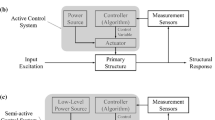Abstract
This paper investigated a noise and vibration concern on a metro train while the train made turns. The study was conducted to identify the root causes of the vibration and noise through hardware experimental testing as well as dynamic computer simulation. The initial investigation indicated the noise came from the bogie of the train. It was between the slewing ring bearing and the friction sets. A lab test was established to duplicate the reported problem and to root out the causes. One-factor-at-a-time method was used to screen the main key factors. Under certain contact conditions, unsmooth turning would occur and cause the noise and vibration. Dynamic simulation was proposed in the study to predict the potential issue. A multibody dynamic model was built with train body, underbody, slewing ring bearing and friction set to simulate the train turning motion. The results showed unsmooth/discontinuous dynamic motions and torque oscillation behaviors. The stop-and-go and stick-and-slip motion led to the vibration. The analysis confirmed the unsmooth friction forces and adhesion could cause the noise and vibration. The computer simulation showed good correlation with the hardware testing. It demonstrated the computer dynamic simulation could be used to predict the potential friction induced vibration issues. In the study, a different substitute material was also investigated through the computer simulation. The results showed the vibration could be effectively reduced if ceramic compound friction material was used.
Similar content being viewed by others
References
K. -S. Baek, K. Kyogoku and T. Nakahara, An experimental study of transient traction characteristics between rail and wheel under low slip and low speed conditions, Wear, 265 (2008) 1417–1424.
T. Ohyama, Tribological studies on adhesion phenomena between wheel and rail at high speeds, Wear, 144 (1991) 263–275.
H. Chen, T. Ban, M. Ishida and T. Nakahara, Adhesion between rail/wheel under water lubricated contact, Wear, 253 (2002) 75–81.
J. A. C. Martins, J. T. Oden and F. M. F. Simoes, A study of static and kinetic friction, Int. J. Engng Sci., 28(1) (1990) 29–92.
E. Marui, H. Endo, M. Hashimoto and S. Kate, Some considerations of slideway friction characteristics by observing stick-slip vibration, Tribology International, 29(3) (1996) 251–262.
H. Mori, O. Mikhyeyev, T. Nagamine, M. Mori and Y. Sato, Effect of a dynamic absorber on friction-induced vibration of a rectangular plate, Journal of Mechanical Science and Technology, 24 (2010) 93–96.
F. Van De Velde and P. De Baets, The relation between friction force and relative speed during the slip-phase of a stick-slip cycle, Wear, 219 (1998) 220–226.
D. Montgomery, Design and analysis of experiments, Wiley, New York, USA (1997).
D. Besterfield, Quality control, Pearson Prentice Hall, New Jersey, USA (2004).
K. Ranjit, Design of experiments using the taguchi approach: 16 steps to product and process improvement, John Wiley & Sons, New York, USA (2001).
G. Box, W. Hunter and J. Hunter, Statistics for experimenters, Wiley, New York, USA (1978).
Author information
Authors and Affiliations
Corresponding author
Additional information
This paper was recommended for publication in revised form by Editor Yeon June Kang
Hsiu-Ying Hwang received her Ph.D degree in Mechanical Engineering from the University of Iowa, Iowa City, USA. She is an assistant professor in the Department of Vehicle Engineering, National Taipei University of Technology, Taipei, Taiwan. Her researches include vehicle design, optimization, vehicle NVH, solid mechanics, finite element methods, and 6-sigma quality control.
Jia-Shiun Chen received his Ph.D degree in Mechanical Engineering from the University of Iowa, Iowa City, USA, and is an assistant professor in the Department of Vehicle Engineering, National Taipei University of Technology, Taipei, Taiwan.
Rights and permissions
About this article
Cite this article
Hwang, HY., Chen, JS. Noise and vibration on the bogie of a mass rapid train. J Mech Sci Technol 25, 2519–2528 (2011). https://doi.org/10.1007/s12206-011-0732-1
Received:
Revised:
Accepted:
Published:
Issue Date:
DOI: https://doi.org/10.1007/s12206-011-0732-1




